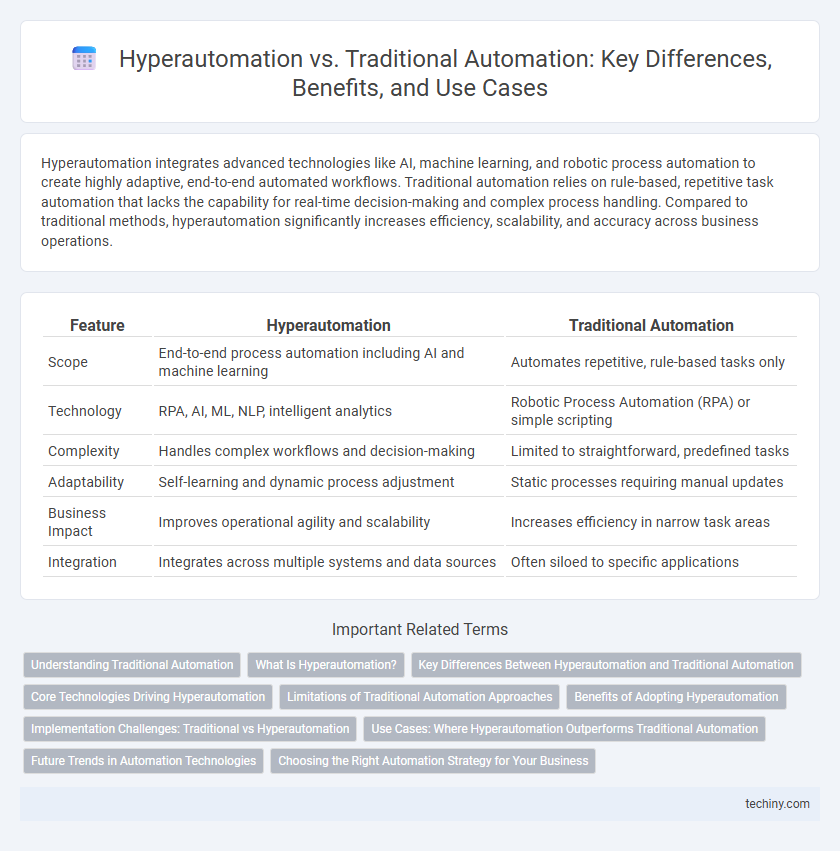Hyperautomation integrates advanced technologies like AI, machine learning, and robotic process automation to create highly adaptive, end-to-end automated workflows. Traditional automation relies on rule-based, repetitive task automation that lacks the capability for real-time decision-making and complex process handling. Compared to traditional methods, hyperautomation significantly increases efficiency, scalability, and accuracy across business operations.
Table of Comparison
| Feature | Hyperautomation | Traditional Automation |
|---|---|---|
| Scope | End-to-end process automation including AI and machine learning | Automates repetitive, rule-based tasks only |
| Technology | RPA, AI, ML, NLP, intelligent analytics | Robotic Process Automation (RPA) or simple scripting |
| Complexity | Handles complex workflows and decision-making | Limited to straightforward, predefined tasks |
| Adaptability | Self-learning and dynamic process adjustment | Static processes requiring manual updates |
| Business Impact | Improves operational agility and scalability | Increases efficiency in narrow task areas |
| Integration | Integrates across multiple systems and data sources | Often siloed to specific applications |
Understanding Traditional Automation
Traditional automation relies on pre-defined rules and repetitive task execution within limited workflows, primarily using scripts and macros to reduce manual effort. It typically handles structured, well-known processes without incorporating real-time decision-making or adaptability. This approach contrasts with hyperautomation, which integrates AI, machine learning, and advanced analytics to automate complex, end-to-end business operations dynamically.
What Is Hyperautomation?
Hyperautomation is an advanced automation approach that combines AI, machine learning, and robotic process automation (RPA) to automate complex business processes end-to-end. Unlike traditional automation, which relies on predefined rules and manual interventions, hyperautomation enables continuous process improvement and adaptability through intelligent analytics and real-time data integration. This enhanced automation strategy drives higher efficiency, scalability, and accuracy across enterprise workflows.
Key Differences Between Hyperautomation and Traditional Automation
Hyperautomation leverages advanced technologies like artificial intelligence, machine learning, and robotic process automation to automate complex business processes end-to-end, while traditional automation typically focuses on automating repetitive, rule-based tasks. Hyperautomation emphasizes process discovery, analytics, and continuous improvement, enabling organizations to adapt quickly to changes, whereas traditional automation often involves static, pre-defined workflows with limited flexibility. The scalability and intelligence of hyperautomation create greater operational efficiency and data-driven decision-making compared to the limited scope and manual intervention of traditional automation systems.
Core Technologies Driving Hyperautomation
Hyperautomation leverages cutting-edge technologies such as Artificial Intelligence (AI), Machine Learning (ML), Robotic Process Automation (RPA), and advanced Analytics to streamline complex business processes beyond the capabilities of traditional automation, which typically relies on rule-based scripting and basic task automation. Core technologies like Intelligent Document Processing (IDP) and Process Mining enable hyperautomation to dynamically analyze and optimize workflows in real time, enhancing accuracy and efficiency. The integration of AI-driven decision-making and end-to-end automation tools defines hyperautomation as a transformative approach that drives digital transformation at scale.
Limitations of Traditional Automation Approaches
Traditional automation approaches are limited by their reliance on rule-based systems that can only handle repetitive, predefined tasks, lacking adaptability to dynamic environments. These systems often require significant manual intervention for maintenance and fail to integrate seamlessly with advanced AI-driven processes. Consequently, they struggle with scalability and cannot efficiently manage the complexity and variability of modern business workflows that hyperautomation addresses.
Benefits of Adopting Hyperautomation
Hyperautomation leverages advanced technologies like artificial intelligence, machine learning, and robotic process automation to streamline complex workflows beyond the capabilities of traditional automation. This approach enhances operational efficiency by enabling end-to-end process automation, reducing human errors, and accelerating task execution. Organizations adopting hyperautomation experience increased agility, scalability, and data-driven decision-making, resulting in significant cost savings and improved customer satisfaction.
Implementation Challenges: Traditional vs Hyperautomation
Implementation challenges in traditional automation often revolve around rigid workflows and limited integration capabilities, resulting in slower adaptation to changing business needs. Hyperautomation introduces complexity due to the integration of AI, machine learning, and robotic process automation, requiring advanced skills and comprehensive governance frameworks. Organizations face difficulties in coordinating multiple tools and ensuring data consistency across platforms during hyperautomation deployment.
Use Cases: Where Hyperautomation Outperforms Traditional Automation
Hyperautomation excels in complex, large-scale processes such as end-to-end supply chain management and customer service automation, where traditional automation struggles with limited scope and repetitive tasks. It integrates AI, machine learning, and robotic process automation to handle unstructured data and dynamic workflows, driving higher efficiency in finance operations and IT service management. Organizations adopting hyperautomation benefit from improved accuracy, scalability, and adaptability compared to traditional automation solutions.
Future Trends in Automation Technologies
Hyperautomation integrates AI, machine learning, and advanced analytics to create adaptive workflows, significantly surpassing traditional automation's rule-based and repetitive task focus. Future trends emphasize intelligent process automation, embedding cognitive capabilities for predictive decision-making and autonomous system optimization. The convergence of hyperautomation with IoT and edge computing will drive real-time efficiency gains and transformative digital ecosystems across industries.
Choosing the Right Automation Strategy for Your Business
Hyperautomation integrates AI, machine learning, and advanced analytics, enabling end-to-end automation of complex business processes, whereas traditional automation typically involves scripting repetitive tasks with limited adaptability. Selecting the right automation strategy requires analyzing your organization's process complexity, scalability needs, and technology readiness to ensure maximum ROI and operational efficiency. Businesses with dynamic workflows and high data volumes benefit more from hyperautomation's intelligent capabilities compared to traditional automation's rule-based approach.
Hyperautomation vs Traditional Automation Infographic

 techiny.com
techiny.com